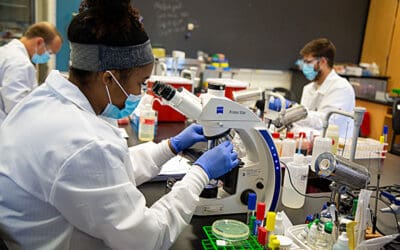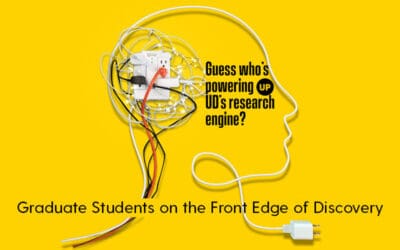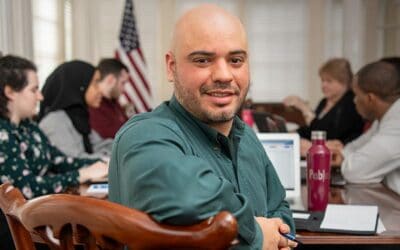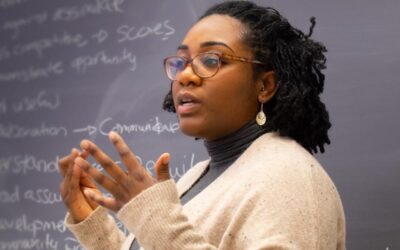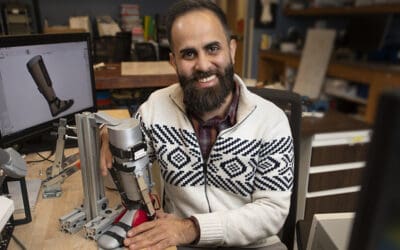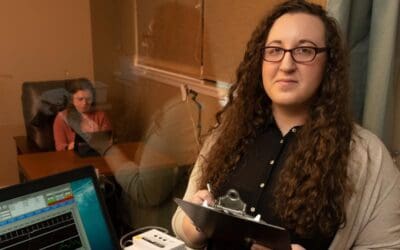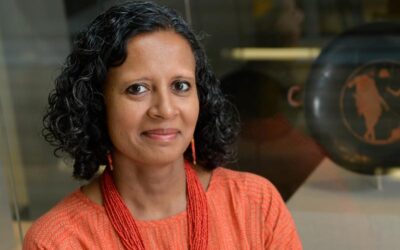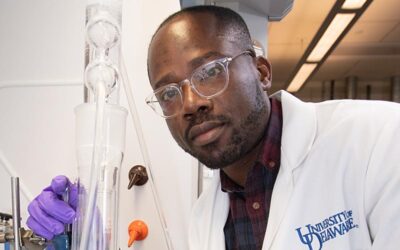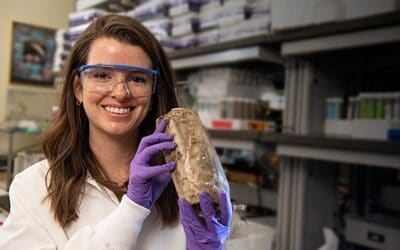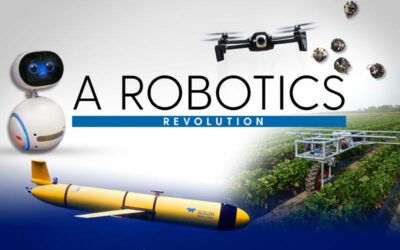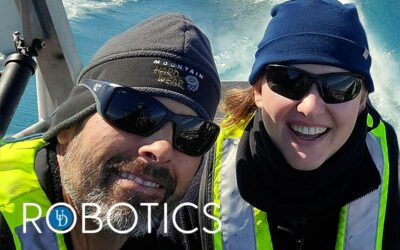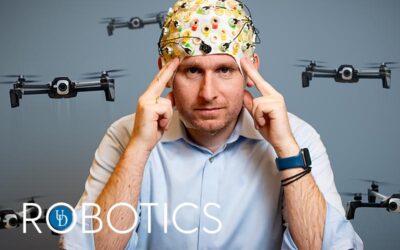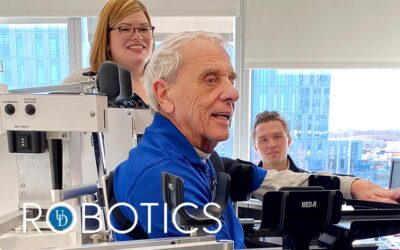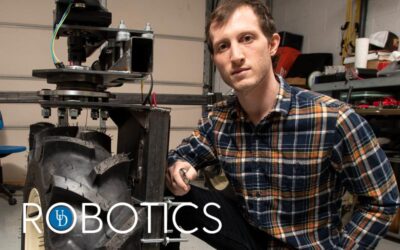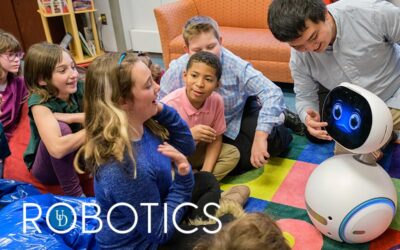UD ROBOTICS
Microrobots for improving health, making organs
Every 10 minutes, another name is added to the national organ transplant list, and the agonizing wait begins. Professor Sambeeta Das’ dream is to develop self-driving microrobots that would act like “helper bees,” working with engineered stem cells, actually doing nanosurgery at the cellular level to create artificial organs and fill a dire need. Pre-pandemic photo by Evan Krape
Meet me on the cutting edge
by Tracey Bryant
“Just call me Sam.” That’s what Professor Sambeeta Das will ask of you, with a warm smile.
But don’t let her humility fool you. She’s boldly forging into little-known territory, into an exciting world you can see only with high-powered microscopes, where sci-fi meets reality.
The assistant professor in UD’s Department of Mechanical Engineering and her students are designing microrobots so small they could get lost inside a human cell. The very tiniest measure about 7 angstroms, the size of a molecule of glucose. The largest are only 10 microns long. A single hair on your head is 20 times thicker.
She envisions many uses for such teensy bots someday, particularly in the medical arena, from delivering a payload of drugs directly to a diseased cell, to sorting sperm for use in artificial insemination. But her dream is to develop self-driving microrobots that would act like “helper bees,” working with engineered stem cells, actually doing nanosurgery at the cellular level, to create artificial organs.
Such a microrobot would come back to its docking position at the end of the day like a Roomba vacuum and be programmed to dissolve after 24 hours or whenever its job was completed. She envisions that 20 years from now, with the help of microrobots, we could have an automated system to generate organs on demand.
It is a need that affects tens of thousands of families. Twenty people die each day in the United States alone, waiting for a new organ. Every 10 minutes, another name is added to the national transplant list, and the agonizing wait begins. Often, it is a bittersweet scenario, with one life ending, as the priceless gift of more time on this planet is conferred to another. The average wait for a person needing a heart transplant is more than six months; the average wait for a kidney is more than three years.

ABOUT SAMBEETA
Sambeeta Das joined UD’s Department of Mechanical Engineering as an assistant professor in 2019. Her research focuses on developing microrobots capable of precision delivery of biochemicals and cellular patterning for use in personalized therapeutics, drug delivery and artificial organs. With work spanning robotics, autonomous systems, physics, organic chemistry, materials engineering, soft matter and biomedical engineering, she is both a practitioner and proponent of interdisciplinary research that serves society. She has a Ph.D. from Penn State, a master’s with distinction from the University of London and a bachelor’s in physics from Presidency College, India.
The microrobots that Das and her students are developing don’t have arms and legs (which many people seem to think a robot has to have). Navigating through blood vessels and cells, they really wouldn’t need such appendages, she explained.
Instead, these experimental bots are made in UD’s high-tech Nanofabrication Facility using photolithography — a printing technique using light — and vapor and chemical deposition techniques that apply infinitesimal amounts of metals or biocompatible polymers in a specific pattern. Dust is an enemy in such manufacturing, which is why this specialized facility with its extreme clean conditions is a necessity, and technicians must wear clean room garb to prevent skin and hair from being shed into the environment.
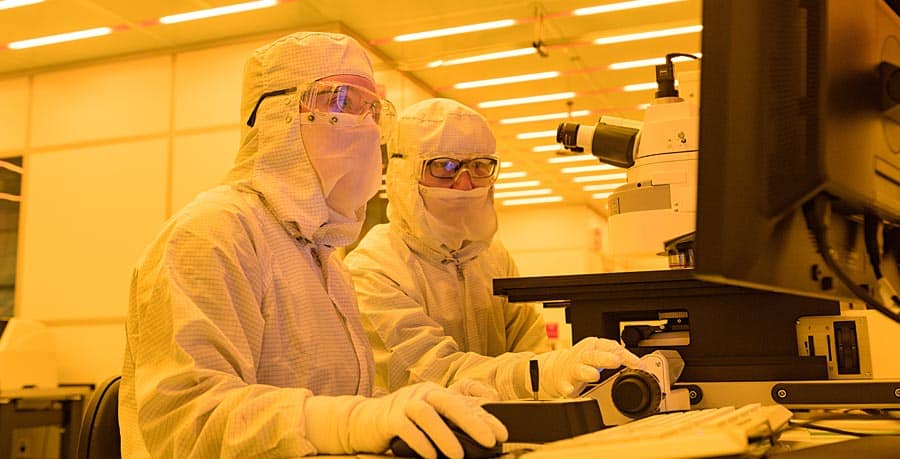
ABOVE: UD’s high-tech Nanofabrication Facility, with its world-class capabilities, is helping Professor Sambeeta Das to make and test experimental microrobots. Creating the bots requires expertise in photolithography — a printing technique using light — combined with vapor and chemical deposition techniques that apply infinitesimal amounts of metals or biocompatible polymers in a specific pattern. Pre-pandemic photo by Evan Krape
Once the microrobot is made, organic chemistry is used to attach various chemicals to it. The team currently is testing a microrobot shaped like a bullet with a magnetic coating inside, which allows it to be guided with a magnetic field or with sound.
Das is ever-mindful of the practical applications as her team takes pioneering steps toward a future that will transform medicine. That’s a key reason why the team is designing microrobots that would respond to sound or light. Hospitals already have ultrasound equipment, and it’s much cheaper than magnetic resonance imaging.
“Instead of thinking about compatibility and cost at the end, we are thinking of those things at the beginning,” she said.
She’s also experimenting with self-driving robots. These are not controlled with magnets or sound, but move and direct themselves using energy created by their own chemistry.
While Das has been on the UD faculty only since fall 2019, she already has received two grants from the National Science Foundation in the past few months — a $299,393 grant from the Biomaterials Program and a $273,841 grant from the Growing Convergence Research program.
“Convergence research” — integrating knowledge, methods and expertise from different disciplines — has been identified by NSF as one of the 10 Big Ideas that will push the frontiers of U.S. research forward, providing novel approaches to solving some of the world’s most pressing problems. In her project, Das is exploring using microrobots to regulate gene expression in liver “organoids,” which are 3D cultures of liver cells originating from biopsies or from stem cells. Her goal is to get microrobots to generate the hexagonal patterns of the liver’s building blocks, called lobules. If successful, the project could define a new area of robot-assisted biological design.
In the related NSF biomaterials project, Das and colleague Kristi Kiick, Blue and Gold Distinguished Professor of Materials Science and Engineering, will work on microrobots capable of triggering the delivery of molecules, such as therapeutics, at desired coordinates with high precision. The project also includes a plan to engage K-12 girls and their caregivers in hands-on robotics activities that will enhance learning strategies and stimulate interest in STEM.
It’s no surprise that Das is among the mavericks leading the charge in microrobotics. At the age of 10, she knew she wanted to be a scientist. She’s the first person in her family to earn a Ph.D., venturing from her native India, first to the United Kingdom for her master’s in organic chemistry and then to the U.S. for her doctorate at Pennsylvania State University with Ayusman Sen, where she got hooked on microscale robots. As a postdoctoral scientist at the University of Pennsylvania, working with roboticist Vijay Kumar, she applied her skills to a fascinating array of projects, including refining the control of a swarm of drones.
Attracted to the University of Delaware by the interdisciplinary culture she loves, the robotics cohort “doing fantastic work,” and opportunities to work with faculty not only in the Department of Mechanical Engineering but other disciplines like physics and chemical engineering as well, Das is right at home and eagerly rolling up her sleeves.
“I’m really excited about what I’m doing,” Das says. “This work is not just cool scientifically, but hugely relevant, with tremendous potential to help people. I’m not a scientist toiling in an ivory tower. I tell my students, it’s very important that whatever research you do, you want to make sure there are real-world applications. I look at it as ‘there has to be a tangible product, and these are the problems we can solve with it.’”
Her dream is to use microrobots to help make artificial organs.
• On average, 20 people die each day in the U.S. due to the lack of available organs for transplant.
• Almost 114,000 people in the U.S. currently are on the waiting list for a lifesaving organ transplant
Source: American Transplant Foundation
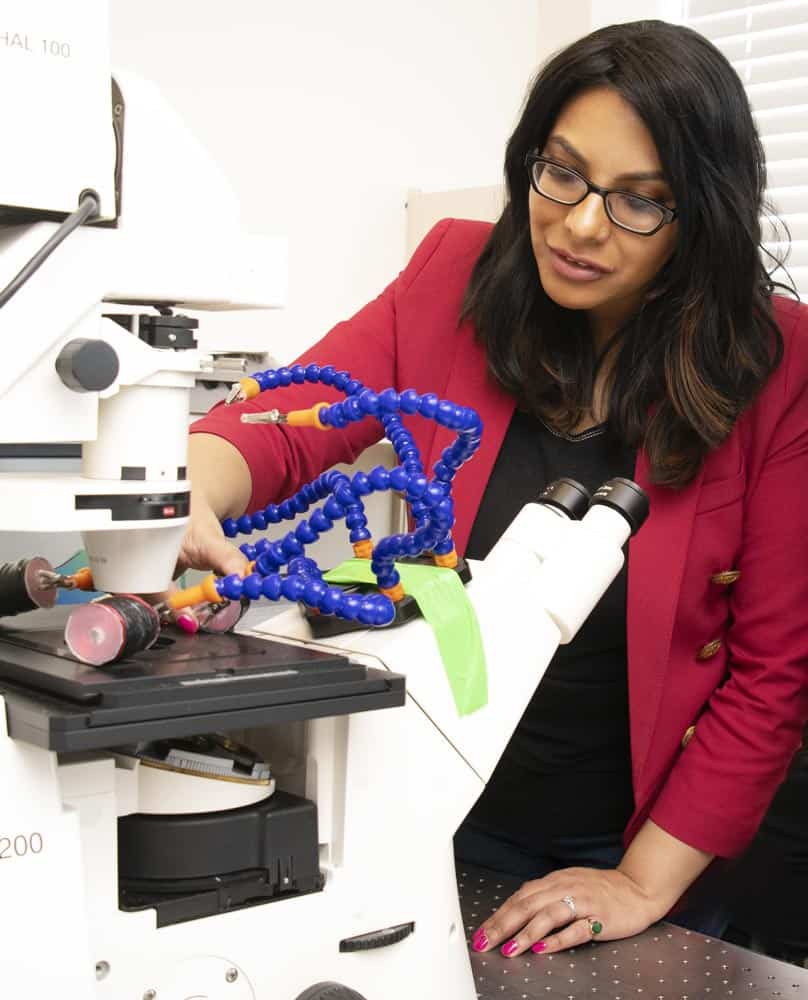
“This work is not just cool scientifically, but hugely relevant, with tremendous potential to help people. I’m not a scientist toiling in an ivory tower. I tell my students, it’s very important that whatever research you do, you want to make sure there are real-world applications. I look at it as ‘there has to be a tangible product, and these are the problems we can solve with it.’”
—SAMBEETA DAS
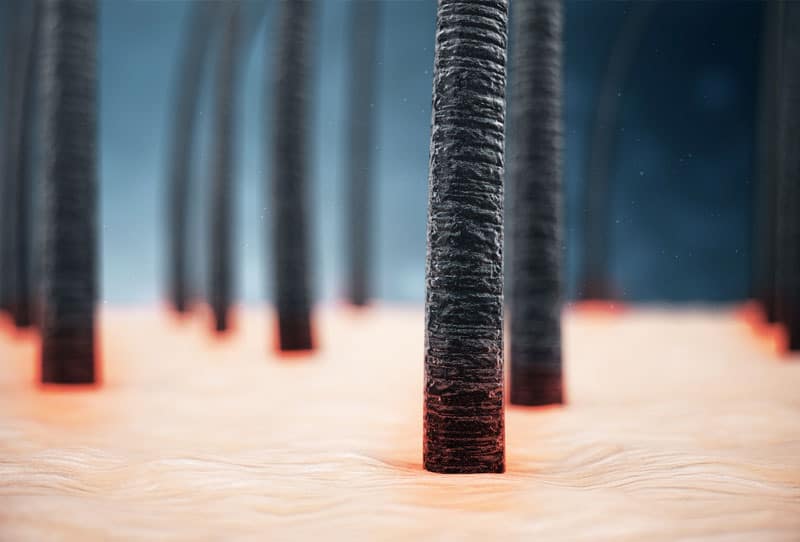
How small is a microrobot?
• The smallest Professor Das is working on measures about 7 angstroms, the size of a molecule of glucose.
• The largest is only 10 microns long. To compare, a human cell is 100 microns across, and a single hair on your head is 200 microns thick.
A UD Robotics Revolution
This special section of our digital magazine highlights an autonomous revolution taking place at UD.
MORE STORIES
From the Vice President for Research, Scholarship and Innovation: Moving Forward
The UD research community continues to navigate COVID-19, with health and safety the highest priority. In spite of hardships, we’re facing the pandemic with vigilance and resilience.
News Briefs
Check out our COVID-19 research, a virtual visit with the editor-in-chief of Science, and undergrads at work on the Frontiers of Discovery.
Honors: Celebrating Excellence
UD faculty and students have won major recognition for their expertise and contributions.
Guess Who’s Powering Up UD’s Research Engine?
This issue of the University of Delaware Research magazine introduces you to a critical creative force at UD — our graduate students and postdoctoral researchers. Their ingenuity is lighting new routes to discovery and solutions.
Front Edge of Discovery: Strengthening democracy for a better world
It all began with a Joseph Conrad novel. Doctoral student Pablo McConnie-Saad discusses his journey to better understand democracy, as the first Whittington Graduate Fellow at the Biden Institute.
Front Edge of Discovery: Developing resilient Black girls
Doctoral student and Graduate Scholar Nefetaria Yates is examining school discipline and the tactics Black girls have developed for dealing with the pressures they face. Her ultimate goal is to elevate voices that have been silenced.
Front Edge of Discovery: Helping children move
Entrepreneur Ahad Behboodi wants to see kids with cerebral palsy move more freely. He plans to commercialize a robotic foot device with the power to help them.
Front Edge of Discovery: A clinical science approach
Lexie Tabachnick, in her fifth year of doctoral studies, helps to mentor other grad students and undergraduates while she studies the powerful impact a UD-developed family intervention program is having on vulnerable kids.
Front Edge of Discovery: Beyond the hands of a potter
Sanchita Balachandran, associate director of Johns Hopkins Archaeological Museum and doctoral student in preservation studies at UD, is uncovering the forgotten makers of ancient Greek ceramics, and in so doing, changing our understanding of the past.
Front Edge of Discovery: Changing the world, one food waste at a time
Elvis Ebikade thinks potato peels hold a lot of promise. He’s working on converting the food waste to valuable chemicals and fuels that can power an environmentally-friendly future.
Front Edge of Discovery: The thing about permafrost is…
As a postdoctoral researcher, Liz Coward collected samples of permafrost from the icy walls of a research tunnel in Alaska to study the carbon stored within it.
A Robotics Revolution
Researchers at the University of Delaware are leveraging robotic systems to gain traction on tough problems. Learn how they are driving forward transformative solutions in agriculture, precision medicine, health care, cybersecurity, marine ecology and more.
UD Robotics: Antarctic food webs
University of Delaware researchers Matthew Oliver and Katherine Hudson think that some biological hotspots in Antarctica may operate less like local farms and more like grocery stores. If they are correct, it could provide new information about how this ecosystem will be affected under climate change.
UD Robotics: Robots these days!
Brain-swarm technology is meant to connect minds and machines. For Associate Professor Panos Artemiadis such robotics research has one purpose: To make life and work better for humans.
UD Robotics: Allies in Overcoming Stroke
Stroke is a leading cause of long-term disability, but UD Professor Jennifer Semrau is working to change that. With the help of a robot, she’s uncovering a critical sixth sense that gets sidelined with stroke.
UD Robotics: Startup with Roots
Adam Stager is working on chemical-free ways to help strawberry farmers improve yield using an autonomous field robot.
UD Robotics: Social Robots
Children have grown up with interactive technologies like Siri, Google and Alexa, but they don’t always know how to stay safe online. UD researchers are working on ways to help them.
A Jewish Oral History
A class helps preserve the precious stories of a little-documented time in Jewish life.
Test Your Knowledge: Getting Back to Nature
To reduce stress and strengthen our immune systems, experts often point us to the outdoors. So let’s get moving! There’s lots to see and hear, absorb and appreciate in nature.


